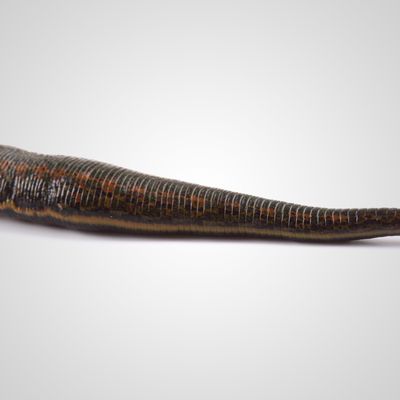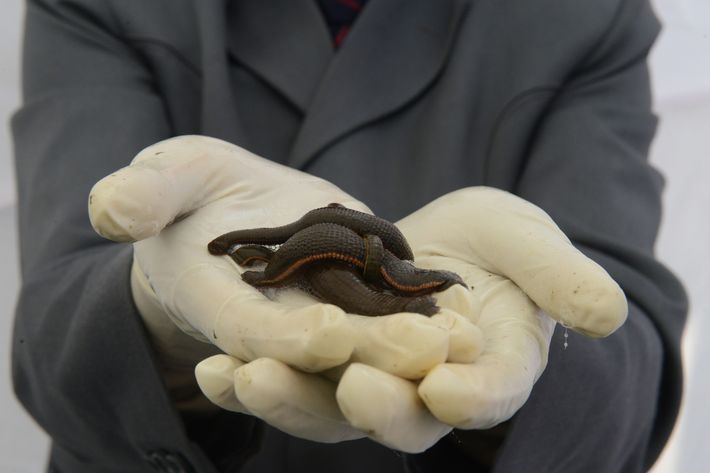
It’s nice to think of modern medicine, like modern war, as high-tech, almost impersonal. Our medications are engineered on a molecular level. Keyhole surgery, computerized imaging, and robotics promise magical, almost noninvasive modes of health maintenance.
So why are doctors using leeches again?
The medicinal leech has three jaws and a hundred teeth. With them it saws into the skin and injects anesthetics to avoid disturbing its meal, chemicals that dilate the blood vessels to get a better flow of the good stuff, and anticoagulants to stop the blood from clotting and impeding its feast. Then it starts to suck. A leech can take in up to ten times its own body weight in human blood. Nightmarish, right?
The therapeutic use of leeches has a long history. It is recorded in ancient Indian and Greek handbooks of medicine. In medieval and early-modern European medicine, patients were bled for a wide variety of supposed imbalances to the bodily humors. Do you have a red skin from fever? Too much blood: leech. Acting flighty? You’re probably too sanguine, which means you have too much blood: leech. (For their remarkably regular recourse to bleeding, doctors themselves were often called leeches.) The 19th century saw a Europe-wide craze for leeching, following the theory of a Napoleonic doctor who held that all illness resulted from inflammation of the intestines: starvation and bleeding, he believed, would purge the body of the toxic effects. Leeches were considered the ideal treatment for everything from nymphomania to tuberculosis. The United States imported millions of leeches from Germany because American leeches were not as good at sucking blood. But eventually chemistry and biology prevailed, and by the beginning of the 20th century, leeches had been consigned to the disgusting history of unscientific medicine.
Then, in 1985, a dog bit off the right ear of a 5-year-old boy from the Boston suburbs. The boy’s physician, a plastic surgeon named Joseph Upton, reattached the ear, but it began to turn black and die: blood could get into it but not out again, because of clotting in the veins. Blood-thinning agents didn’t help, nor did lancing the ear. Luckily, however, Upton remembered an article he had once read about the therapeutic effects of leeches on congested tissue.

He contacted a company, Biopharm, that grew and sold leeches. (It had been set up only a couple of years earlier by zoologist Roy T. Sawyer, who had written a definitive three-volume study of the biology and behavior of leeches, and who suspected they were due a medical comeback because of all those interesting chemicals in their saliva.) Biopharm was in Wales, so 30 leeches were flown across the Atlantic to Boston. Joseph Upton attached two to the boy’s congested ear, and in minutes it began to recover its healthy color. After a couple of days the organ was fine, and Upton became the first doctor to have successfully reattached the ear of a child using microsurgery. Plus a couple of vampiric slugs.
Upton’s rediscovery had in fact been predated by others; remember, after all, that he’d seen an article on the subject. Two plastic surgeons in Yugoslavia had announced the positive results of their experimentation with leeches to treat vein congestion in the British Journal of Plastic Surgery in 1960, though they concluded that other methods should be sought. In 1972 a French surgeon, Jacques Baudet, successfully used leeches to prevent postoperative blood clotting, and his techniques were imitated in France and the U.K. Baudet’s work was described in the New York Times in 1981, and Upton may have remembered this report, if not the earlier medical articles, four years later when faced with a child’s ear turning black. In any case, the third time being lucky — it was Upton’s sensational success that made the headlines and ushered in the real leech renaissance. Leeches became widely used in the United States, and in 2004 the FDA approved leeches as a “medical device,” enabling new leech-farming companies from other countries to enter the market.
Today leeches are frequently used in reattachment operations, skin grafts, and reconstructive plastic surgery, since they are so good at keeping the patient’s blood flowing in the damaged area, which helps the veins to knit together again. The active anticoagulant in leech saliva, a protein named hirudin, can be produced separately, and Biopharm has isolated and resynthesized many other active and useful compounds from the medicinal leech and other species — including the terrifying giant Amazon leech, which is the length of your forearm and stabs its prey with a six-inch needle proboscis.

But the humble old medicinal leech still has a winning combination of effects, plus it is cheap — and automatically reproduces itself. Perhaps even more surprisingly, leeches also relieve symptoms of osteoarthritis when applied to the knees, because of anti-inflammatory and other compounds in their saliva that are still not fully understood. The use of leeches has fewer side effects than the standard treatment of non-steroidal anti-inflammatory drugs, and they are more effective in relieving pain and stiffness than the best topically applied medication. And so one traditional use of leeches, in Ayurvedic medicine and other systems — to relieve pain and inflammation — had it right all along.
As it happened, Joseph Upton had previous experience in resurrecting disgusting medical practices from the past. He had served as an army doctor posted in Augusta, Georgia, during the Vietnam War, when many returning soldiers had badly infected wounds. Upton knew that Civil War doctors had used maggots — they feed only on dead flesh and so are effective at debriding (cleaning out) unviable tissue from wounds. He took a chance and used maggots on his soldiers — with great success, until the brass heard about it and threatened him with a court-martial. Years later, when Upton had his idea to save the boy’s ear, he remembered that experience and decided not to tell his superiors that he planned to use leeches. He just went ahead and did it. Sometimes, a rethinker has to break the rules.
Excerpted from Steven Poole’s Rethink: The Surprising History of New Ideas, out from Scribner November 15.